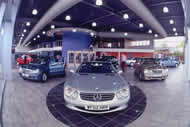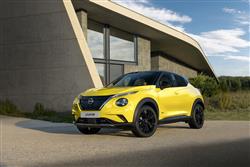Presenter Jonathan Crouch
Click here to view Jonathan's biography.
Used Car Guides
Group Tests
Bespoke Dealer Videos
Home | New Car Road Tests | 4x4s | Nissan Juke
Road Test Video
New Car Road Test | Nissan Juke
STILL CRAZY
The Nissan Juke is wilfully weird but it's hit a nerve with British buyers who love the thing. Jonathan Crouch takes a look at the latest version of the MK2 model.
Ten Second Review
If you need a car that blends into the background, look somewhere else. Nissan's Juke is a small SUV that's sold like hot cakes because it makes a visual statement. This improved version of the second generation model keeps the design extreme but adds a more practical cabin complete with larger, more sophisticated screen tech. As before, there's the option of a frugal Hybrid engine if you can stretch to it.
Background
There's nothing quite like a Nissan Juke, part SUV, part sports coupe, part hot hatch - with a few bike and rallycar genes thrown in for good measure. It sounds an unpromising mix but against the odds, Nissan has made it work and in the original first generation version of this car which sold until 2019, defined once and for all what the market's smallest breed of crossover-class car should be like.
What was most amazing about the original Juke was that a company the size of Nissan could build it. The usual procedure is for a maverick designer to come up with just such a concept only for company heads to shelve it, for customer clinics to reject it or for marketing pressure to water it down. Somehow the earlier Juke survived all of these potential trap doors and from its launch, the MK2 model continued with the same divisive but trendy theme, remaining arguably the most distinctive family car on sale. Five years into its production life, Nissan updated this MK2 Juke in Spring 2024 - and it's that improved design we look at here.
Driving Experience
There are no powertrain or handling changes as part of the updates made to the improved version of this second generation Juke. Which means that, as before, the most affordable versions come powered by a 1.0-litre turbocharged three-cylinder DIG-T 114 petrol engine, with either a six-speed manual gearbox or a seven-speed dual-clutch automatic. Power stands at 114PS with up to 200Nm of torque available on overboost. Nissan claims 0-62mph in 10.4 seconds for the manual and 11.1 seconds for the DCT automatic variant, with both topping out at 112mph.
The alternative is a 1.6-litre Hybrid engine developing 143PS, using an electric motor fed by a 1.2kWh battery and mated to a clever 'multi-modal' clutchless auto gearbox. Nissan claims that with this powerplant, up to 80% of urban journeys can be conducted on electric power alone. All Hybrid versions come equipped with Nissan's e-Pedal Step which, when activated, allows the movement of the car to be controlled using just the accelerator pedal. When the foot is lifted from the accelerator, moderate braking is applied (up to 0.15g) and will decelerate the Juke to a crawl (about 3mph).
Of course there's plenty of driver-assistance technology, primarily Nissan ProPILOT, the brand's semi-autonomous driver aid. This is capable of controlling the throttle, braking and steering while driving in a single lane on motorway-style roads. It's optional on N-Connecta trim cars and standard from Tekna grade upwards. In addition, the Juke gains intelligent automatic emergency braking with pedestrian and cyclist detection, speed-limit and traffic-sign recognition, lane-keep assist and rear cross-traffic alert.
Design and Build
Unless you count a new bright yellow paint option, there are no exterior changes to this Juke as part of this mid-term update. So, as before, it does still look like either something dredged up from the abyssal depths of the ocean or a fun, friendly and futuristic little runabout, depending on your perspective. Whichever camp you're in, you have to hand it to Nissan for not losing its resolve and watering this design down. Buyers of the first generation model will recognise this second generation version with its exaggerated wheel arches, rising window line, strong shoulders and squat rear end. The full-LED circular headlights placed high on the front bumper reference those of the original Juke's, and feature a distinctive Y-shaped signature. Above them sit slim LED daytime running lights that flank the nose and a narrow grille.
Changes have however, been made inside the cabin, where the dashboard has been completely redesigned to accommodate two much larger screens. There's now a 12.3-inch digital TFT combimeter instrument screen (up from 7-inches before) and a new central infotainment monitor, also 12.3-inches (up from 8-inches before).
The appearance of the combimeter instrument display can be cycled between two different basic layouts, with the classic layout showing two dials and a central space containing additional information. Alternatively, the 'enhanced' layout presents the road speed and engine speed which are displayed on a pair of dials which are inclined and give a three-dimensional perspective. In the central section between the dials, the driver can display navigation directions, including a map, as well as fuel economy, audio information, eco-drive performance, tyre pressures and other key information.
The upgraded infotainment system comes with a more intuitive home screen which allows the user to tailor the screen to include the 'widgets' for the functions they use the most frequently, much like they would with the home screen of their smart phone. Additionally, the infotainment set-up features improved voice recognition and 'natural language understanding' capability. This endows the system with a wider range of phrases and expressions that the system can understand as a command, ignoring hesitations or pauses. The 'Android Auto' and 'Apple CarPlay' systems are now wireless.
Other updates include a bigger 6.6-litre glovebox (29% larger than before), a redesigned more supportive armrest and the standardisation of a wireless charging pad on most models which can take a smartphone as large as an iPhone 12 Pro Max. And there are now both USB-A and USB-C ports.
Otherwise, things are much as before. Which means rear seated folk will need to be on fairly friendly terms - but you'd expect that in a supermini-based small SUV. At least they now get USB-A and USB-C ports in the rear. Out back, the hatch accesses a boot that's 422-litres in size.
Market and Model
From the launch of the revised version of this MK2 Juke, Nissan was offering a range priced from around £25,500 - the sum required for base 'N-Connecta' trim. From there, the range progresses through mid-range 'Tekna'-spec to the top identically-priced 'Tekna+' and 'N-Sport' models (which from launch cost £28,400). Those prices are for the conventional DIG-T 114 engine with manual transmision;' add £1,500 more for the alternative 7-speed automatic. Choose your Juke in Hybrid form (which from launch was priced from just over £30,000 with 'N-Connecta' trim) and automatic transmission comes as standard.
The two new 12.3-inch cabin screens come as standard and, even with 'N-Connecta' trim, you get 17-inch wheels, 'NissanConnect' navigation with 'TomTom Traffic', a wireless 'phone charger, all-round parking sensors, automatic climate control and a rear view camera with a higher-definition screen. Plus there's cruise control with a speed limiter function and high beam assist. Buyers will also want cutting-edge media connectivity, so on-board Wi-Fi appears, as does a voice-controlled Google Assistant.
Across the range, Nissan's taken the opportunity of this Juke update to introduce a standard 'Intelligent Driver Alertness' system to combat driver drowsiness. 'Lane Keep Assist' is an option, and standard above base trim. It monitors the Juke's position in the lane on a highway, for example, and if the car moves too close to the limit of the lane, as defined by the white lines, it will trigger a vibration in the steering wheel to attract the driver's attention. Without correction, the car will intervene and correct the direction to maintain the car's trajectory in the lane.
As for aesthetics, well there's a new bright yellow exterior colour option - a pearlescent Pearl White's also now offered. And new wheel trim options are available too.
Cost of Ownership
The second generation Juke is looking to retain its predecessor's reputation as being inexpensive to run and should deliver on that promise thanks to its efficient 1.0-litre three cylinder engine. A relatively low kerb weight helps here, achievable thanks to the use of lightweight, high-tension steel in the body. Also quite light is this car's CMF-B Nissan/Renault Alliance platform, shared with one of its closest rivals, the Renault Captur. All of this should mean a competitive set of running cost stats. From the manual 1.0-litre model, expect a WLTP-rated combined cycle fuel figure of 47.9mpg and a WLTP-rated CO2 figure of 133g/km. For the Hybrid, it's up to 56.5mpg and up to 114g/km. The Hybrid uses a 20PS belt starter/generator and always starts off in electric mode.
On all Jukes, service intervals will come round every 12 months or 12,500 miles, depending on which comes soonest. As part of any Nissan dealer visit with your car, you'll be provided with a free courtesy vehicle and a video health check for your Juke that you can watch on your 'phone or computer. Nissan also provides a three year, 60,000-mile warranty as standard and that can be lengthened to four years but with the same mileage cap. This recognises that most drivers of small SUVs tend to cover lower distances, but aims to give added peace of mind for those looking to keep their car for longer. And in case of any problems, there's breakdown assistance with roadside help included with the car's protection package.
Summary
You probably know the guy who complains that all new cars look the same but has nothing good to say when a brand like Nissan brings us something different and fresh. Don't be that guy. The Juke has deservedly carved itself a lucrative niche for itself with an inexpensive vehicle that drives well, is cheap to run and which isn't afraid to assert its own personality. The second generation model's design remit hasn't altered that fundamental appeal and updating the cabin, along with adding more technology certainly isn't going to do the Juke's prospects any harm.
It remains an unusual proposition, with an appeal that extends beyond the small crossover segment and also attracts the kind of buyers who might otherwise consider trendy small runabouts like Fiat's 500 and the MINI Hatch. Juke buyers think that this car makes urban trinkets like those look rather dull and compromised. It's an original. In every sense.
Related Road Tests
Browse the other models
Currently viewing New Car Road Tests, switch to Used Car Road Tests
Select a model to browse through the videos.





.jpg)
.jpg)
.jpg)
.jpg)
.jpg)
.jpg)
.jpg)
.jpg)
.jpg)
.jpg)
